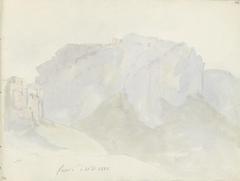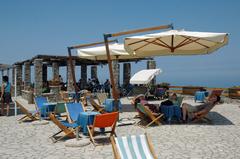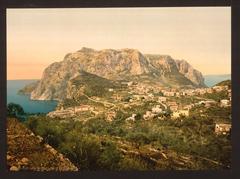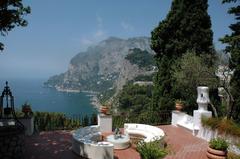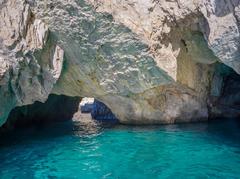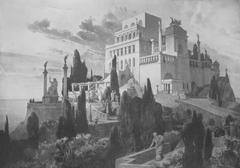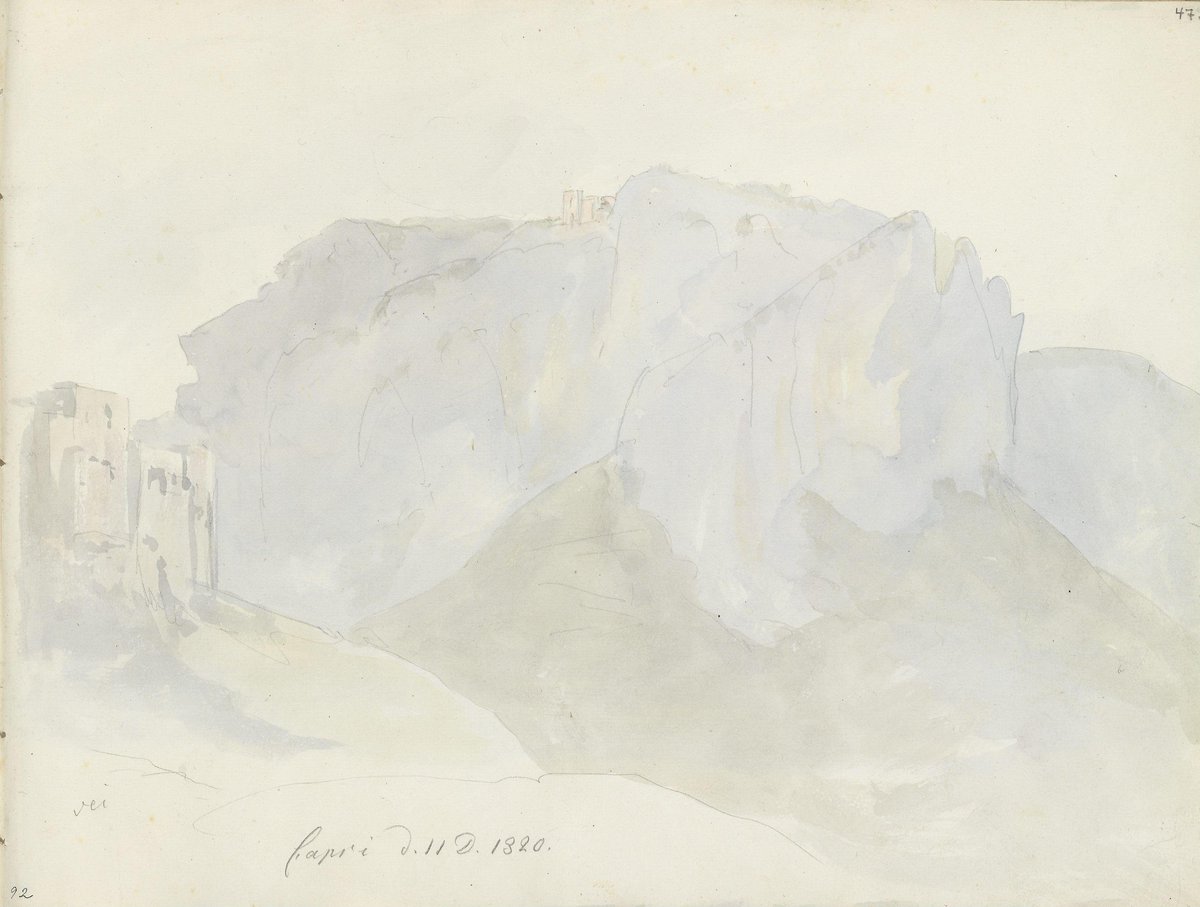
Comprehensive Guide to Visiting Monte Solaro, Capri, Italy
Date: 16/08/2024
Introduction
Monte Solaro, the highest peak on the island of Capri, Italy, stands as a beacon of natural beauty and historical depth. Rising majestically at 589 meters above sea level, it offers panoramic vistas that encompass the entire island, the Bay of Naples, and the Amalfi Coast. More than just a scenic viewpoint, Monte Solaro is a site of immense historical significance. From the ancient Phoenician and Greek watchtowers to the Roman villas constructed by Emperor Augustus, the mountain has been a strategic and cultural landmark for centuries (initaly.wiki). During the medieval period, it served as a refuge against pirate invasions, with the 16th-century Forte di Monte Solaro standing as a testament to these turbulent times (initaly.wiki). The early 19th century saw its involvement in the Napoleonic Wars, adding layers of intrigue and historical depth (livetheworld.com). Besides its historical importance, Monte Solaro has inspired artists and writers such as Ferdinand Gregorovius and Jean-Baptiste Corot, further cementing its place in cultural history (initaly.wiki). This comprehensive guide aims to provide detailed information on Monte Solaro’s visiting hours, ticket prices, travel tips, and historical significance, ensuring you make the most out of your visit to this captivating destination.
Table of Contents
- Introduction
- Historical Significance
- Visitor Information
- The Summit Experience
- Hiking Trails
- Panoramic Views
- Sunset Spectacle
- Flora and Fauna
- Nearby Attractions
- Conclusion
- Sources
Historical Significance
Ancient Times and Strategic Importance
Monte Solaro has been a site of strategic importance since ancient times. The Phoenicians and Greeks were among the first to recognize its value, constructing watchtowers on its summit to monitor maritime activity. These early structures served as lookout points, providing a vantage point over the Tyrrhenian Sea and the surrounding waters. The strategic importance of Monte Solaro continued into the Roman era, with Emperor Augustus constructing a villa on the mountain, further emphasizing its significance (initaly.wiki).
Medieval Refuge and Fortifications
During the Middle Ages, Monte Solaro became a refuge for islanders seeking protection from marauding pirates and invaders. The remains of the Forte di Monte Solaro, a fortress built in the 16th century, stand as a testament to this turbulent period. The fort served as a defensive stronghold, protecting the island from attacks by sea and land. Its strategic location allowed defenders to spot approaching enemy ships and sound the alarm, enabling the islanders to prepare for defense (initaly.wiki).
The Fortino di Bruto and Napoleonic Wars
In the early 19th century, Monte Solaro played a role in the Napoleonic Wars. The mountain is home to the Fortino di Bruto, a blockhouse that was used in battles between Britain and France. This historical relic adds a touch of intrigue to the already captivating landscape. The Fortino di Bruto stands as a reminder of the island’s involvement in broader European conflicts and its strategic importance during this period (livetheworld.com).
Artistic Inspiration in the 19th Century
The 19th century marked a new era of transformation for Monte Solaro, as it became a popular destination for European travelers and artists. The island’s natural beauty and historical charm captivated many visitors, including the German writer Ferdinand Gregorovius and the French painter Jean-Baptiste Corot. These artists made the ascent to Monte Solaro to capture the breathtaking views in their works, further cementing the mountain’s place in cultural history (initaly.wiki).
The Hermitage of Santa Maria a Cetrella
Near the summit of Monte Solaro lies the Hermitage of Santa Maria a Cetrella, built in the 15th century. This secluded spot, surrounded by vineyards, served as a place of spiritual retreat for hermits belonging to the orders of the Franciscans and the Dominicans. The sailors of Anacapri would sometimes come to venerate an image of St. Mary before embarking on dangerous expeditions. The hermitage’s name is derived from the aromatic herb lemon balm, which grows abundantly in the area (naples-napoli.org).
Castello Barbarossa
On one of the peaks of Monte Solaro, at an elevation of 412 meters, stand the ruins of Castello Barbarossa. This castle owes its name to the pirate and Ottoman Admiral Khair-ad-din, who conquered the fortress in 1535 and destroyed it in 1544. The castle is thought to have been built between the end of the 9th century and the 12th century AD. Today, the site serves as a birding station and is generally closed to the public, with guided tours organized periodically (naples-napoli.org).
The Statue of Emperor Augustus
At the summit of Monte Solaro, visitors can find a statue of Emperor Augustus, who first landed on Capri. This statue not only serves as a historical marker but also as a tribute to the emperor’s influence on the island. The presence of this statue underscores the long-standing historical significance of Monte Solaro and its connection to notable historical figures (Wikipedia).
Visitor Information
Ticket Prices
Visitors can reach the summit of Monte Solaro via a chairlift from Piazza Vittoria in Anacapri. The cost for a round trip ticket is approximately €12. Single tickets are also available for around €9. Please note that prices may vary, so it’s advisable to check the latest rates on the official website.
Opening Hours
The chairlift operates from 9:30 AM to 5:00 PM daily, but hours can vary seasonally. It’s recommended to visit early in the day to avoid crowds and enjoy the serene environment.
Travel Tips
- Best Time to Visit: The best time to visit Monte Solaro is during the spring and autumn months when the weather is mild and the tourist crowds are smaller.
- Hiking: For those seeking a more adventurous experience, hiking up to the summit is an option. The trek takes approximately an hour to an hour and a half.
- Nearby Attractions: While in Capri, consider visiting other nearby attractions such as the Blue Grotto, Villa Jovis, and Anacapri.
- Accessibility: The chairlift is not wheelchair accessible. However, visitors with mobility issues can still enjoy beautiful views from the lower levels of Monte Solaro.
- Photography: Don’t forget your camera! Monte Solaro offers some of the best photographic spots on the island.
FAQs
What are the opening hours of Monte Solaro?
- The chairlift operates from 9:30 AM to 5:00 PM daily, but hours can vary seasonally.
How much are tickets to Monte Solaro?
- A round trip ticket for the chairlift costs approximately €12, while a single ticket costs around €9.
What is the best way to reach Monte Solaro?
- The easiest way to reach the summit is by chairlift from Piazza Vittoria in Anacapri. Hiking is also an option for those who prefer a more physical challenge.
The Summit Experience
Monte Solaro offers an unparalleled 360-degree panoramic view that encompasses the entire island, the Bay of Naples, and the Amalfi Coast. Visitors can reach the summit either by hiking or by taking the chairlift from Piazza Vittoria in Anacapri. The chairlift ride, which takes about 12 minutes, provides a leisurely ascent with stunning views of the island’s white houses, terraced gardens, and rugged cliffs (Lonely Planet).
Hiking Trails
For those who prefer a more active approach, the hike to the summit is a rewarding experience. The trail begins at Via Axel Munthe and continues up Via Salita per il Solaro. The hike, which takes approximately 45 minutes to an hour, is moderately challenging but manageable for those with a reasonable level of fitness. Along the way, hikers will encounter the pass known as La Crocetta, marked by a distinctive iron crucifix. From here, the path diverges: one route leads to the summit, while the other descends into the valley of Cetrella, home to the small hermitage of Santa Maria a Cetrella (Lonely Planet).
Panoramic Views
The panoramic views from Monte Solaro are nothing short of breathtaking. On a clear day, visitors can see the entire Gulf of Naples, the Sorrentine Peninsula, and the distant islands of Ischia and Procida. The view also includes the iconic Faraglioni rock formations, which rise majestically from the sea. The terrace at the summit, often referred to as the “Terrace of Capri,” is a popular spot for photography and offers a perfect vantage point for capturing the island’s natural beauty (Monte Solaro Capri).
Sunset Spectacle
One of the most captivating experiences at Monte Solaro is witnessing the sunset. As the sun dips below the horizon, the sky transforms into a canvas of vibrant colors, casting a golden glow over the island and the surrounding sea. This natural spectacle is a favorite among visitors and is often described as one of the most beautiful sunsets in the world. The terrace becomes a special place during this time, attracting nature enthusiasts and photographers alike (Monte Solaro Capri).
Flora and Fauna
Monte Solaro is not only a visual delight but also a haven for nature lovers. The mountain is home to a diverse range of flora and fauna, including several endemic species. The slopes are covered with Mediterranean scrub, featuring plants such as myrtle, rosemary, and wild orchids. Birdwatchers can spot various species of birds, including peregrine falcons and kestrels, which nest in the cliffs. The naturalist Ignazio Cerio catalogued much of Capri’s flora and fauna in the 19th century, highlighting the island’s rich biodiversity (Wikipedia).
Nearby Attractions
Monte Solaro is just one of the many attractions on the island of Capri. Nearby, visitors can explore the ruins of the medieval Saracen defense tower, Torre Saracena, and the striking Moroccan-style Casa Rossa, built by American colonel John Clay MacKown in 1876. The Chiesa di San Michele in Anacapri is famous for its beautiful floor depicting the story of Adam and Eve in multicolored tiles (Lonely Planet).
Conclusion
Monte Solaro offers an unparalleled blend of natural splendor and historical richness, making it a must-visit destination for anyone traveling to Capri. Whether you choose to ascend via the scenic chairlift or embark on the rewarding hike, the summit provides breathtaking panoramic views that capture the essence of Capri’s beauty. The historical remnants, from ancient watchtowers to medieval fortresses and Napoleonic blockhouses, add layers of intrigue and significance to your visit. Don’t miss the Hermitage of Santa Maria a Cetrella and the ruins of Castello Barbarossa, which offer unique glimpses into the island’s past. The strategic importance of Monte Solaro throughout history, coupled with its cultural impact, makes it a compelling destination for history buffs, nature lovers, and art enthusiasts alike. To enhance your visit, plan your trip during the spring or autumn months for mild weather and fewer crowds. For more information and updates, be sure to visit the official websites and consider downloading the Audiala mobile app for the latest travel tips and special offers. Monte Solaro is more than just a viewpoint; it is a journey through time and nature that will leave you with lasting memories.
Sources
- Monte Solaro, 2024, initaly.wiki source
- Monte Solaro, 2024, livetheworld.com source
- Monte Solaro, 2024, naples-napoli.org source
- Monte Solaro, 2024, Lonely Planet source
- Monte Solaro, 2024, Wikipedia source
- Monte Solaro, 2024, Monte Solaro Capri source
- Monte Solaro, 2024, whatkirstydidnext.com source
- Monte Solaro, 2024, Capri.net source
- History of Capri, 2024, Wikipedia source
